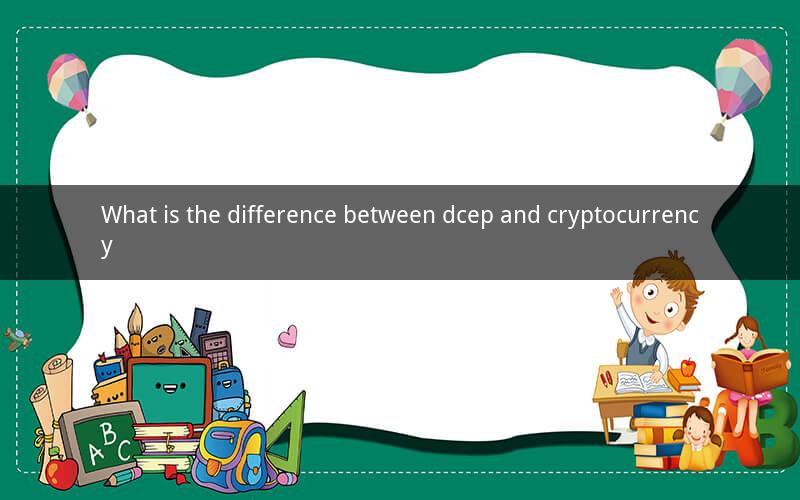
The Distinction Between DCEP and Cryptocurrency
Table of Contents
1. Introduction to DCEP
2. Understanding Cryptocurrency
3. The Legal and Regulatory Framework
4. Technological Aspects
5. Economic Impact
6. Privacy Concerns
7. Adoption and Use Cases
8. Conclusion
1. Introduction to DCEP
The Digital Currency Electronic Payment (DCEP), also known as the digital yuan, is a digital currency issued by the People's Bank of China (PBOC). It is designed to complement the physical currency in circulation and aims to streamline transactions, enhance financial inclusion, and support the development of a modern payment system.
2. Understanding Cryptocurrency
Cryptocurrency, on the other hand, is a digital or virtual asset designed to work as a medium of exchange. Unlike traditional currencies, cryptocurrencies operate on decentralized networks, often referred to as blockchain technology. Bitcoin, Ethereum, and Litecoin are some of the most well-known examples of cryptocurrencies.
3. The Legal and Regulatory Framework
DCEP operates within the legal and regulatory framework of the People's Republic of China. It is a fiat currency, meaning it is backed by the government and has the same legal status as physical currency. Cryptocurrency, however, is often unregulated or subject to varying regulations depending on the country and jurisdiction.
4. Technological Aspects
DCEP is based on a combination of blockchain and distributed ledger technology, providing a secure and transparent transaction system. Cryptocurrencies, particularly those built on blockchain, also rely on these technologies but may differ in terms of scalability, security, and consensus mechanisms.
5. Economic Impact
The economic impact of DCEP and cryptocurrency can be significant. DCEP is expected to reduce the cost of cross-border transactions, lower the risk of counterfeit currency, and foster financial innovation. Cryptocurrency, on the other hand, has the potential to disrupt traditional financial systems, increase financial inclusion, and facilitate peer-to-peer transactions.
6. Privacy Concerns
DCEP is designed to provide a level of privacy similar to that of physical currency, as it does not require personal information to be disclosed during transactions. Cryptocurrency, however, often raises privacy concerns due to its decentralized nature, which can make it difficult to trace transactions and monitor illegal activities.
7. Adoption and Use Cases
DCEP is currently being tested in various pilot programs in China, including transportation, retail, and government services. Its adoption is expected to grow as more entities and individuals become aware of its benefits. Cryptocurrency has been widely adopted for various purposes, including online purchases, investment, and as a store of value.
8. Conclusion
In conclusion, the main differences between DCEP and cryptocurrency lie in their legal status, technological foundations, economic impact, privacy concerns, and adoption. While both aim to revolutionize the way we conduct transactions, they approach these goals in distinct ways.
---
Questions and Answers
1. Question: What is the primary goal of DCEP?
Answer: The primary goal of DCEP is to complement the physical currency in circulation and enhance the efficiency of the payment system.
2. Question: How does DCEP differ from traditional fiat currency?
Answer: DCEP is a digital version of the fiat currency, offering a digital alternative to physical cash.
3. Question: What are the key technological features of DCEP?
Answer: DCEP is based on blockchain and distributed ledger technology, ensuring security and transparency.
4. Question: Can DCEP be used internationally?
Answer: DCEP is currently being tested within China, but its international use is yet to be determined.
5. Question: How does cryptocurrency differ from traditional banking systems?
Answer: Cryptocurrency operates on decentralized networks, allowing for peer-to-peer transactions without the need for intermediaries.
6. Question: What are the potential benefits of using cryptocurrency?
Answer: Cryptocurrency offers benefits such as lower transaction fees, increased financial inclusion, and the potential for borderless transactions.
7. Question: Are there any drawbacks to using cryptocurrency?
Answer: Cryptocurrency can be subject to high price volatility, regulatory uncertainty, and security risks.
8. Question: How does privacy differ between DCEP and cryptocurrency?
Answer: DCEP aims to provide privacy similar to physical currency, while cryptocurrency may raise privacy concerns due to its decentralized nature.
9. Question: What are some use cases for DCEP?
Answer: DCEP is being tested in various sectors, including transportation, retail, and government services.
10. Question: How might DCEP impact the future of digital payments?
Answer: DCEP has the potential to significantly impact the future of digital payments by providing a secure, efficient, and privacy-conscious alternative to traditional systems.